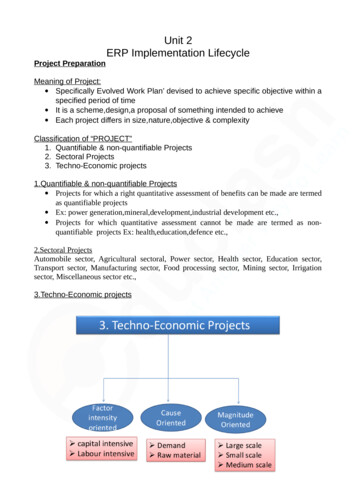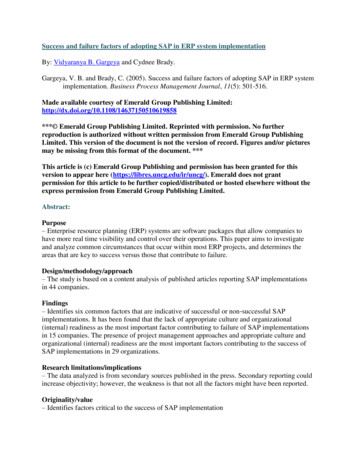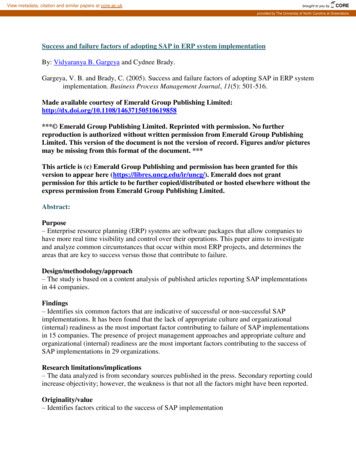
Transcription
Proceedings of the 2nd European International Conference on Industrial Engineering and OperationsManagement, Paris, France, July 26-27, 2018Critical Success Factors for ERP Implementations : AMoroccan Case StudyMohamed-Iliasse Mahrazm.mahraz@hotmail.frMohamed-Iliasse Mahraz1, Loubna Benabbou1, Abdelaziz Berrado2,1-Equipe MOAD-SCM, 2-Equipe AMIPS, Ecole Mohammadia d’Ingénieurs,Mohammed V University of Rabat, Moroccom.mahraz@hotmail.fr , benabbou@emi.ac.ma , berrado@emi.ac.maAbstract:Enterprise resource planning (ERP) is an enterprise-wide information system designed to coordinate allthe resources, information, and activities, it provides a unified enterprise view of the business for allfunctions and departments, and also an enterprise database for all business transaction, but despite allthe benefits they are also seen as an expensive, profoundly complex, and notoriously difficult toimplement because it is different from other IT systems. There are as many reasons for successful ERPimplementations as there are for failed projects.It is really difficult to measure the success of a projectof implementation because each organization can look at the success of ERP implementation differently.It is important for the organization to have as much information as possible before embarking an ERPproject, and also respect some critical factor for the success of the project. Measuring and knowing theimportance of each factor will help an organization to make the right decision, at the right moment. Thissurvey examines and also tries to determine the necessary critical success factors (CSFs) inimplementing Enterprise Resource Planning (ERP) systems and also try to examine the impact of thistechnology on the performance of the whole organization. We were able to identify six critical successfactors by the survey. They are (1) Infrastructure, (2) Business process management, (3) Projectmanagement, (4) Project team, (5) Culture, communication, and change management, and (6) Trainingand education.1122
Proceedings of the 2nd European International Conference on Industrial Engineering and OperationsManagement, Paris, France, July 26-27, 2018Introduction:In a rapidly changing economic context, the main challenge facing the majority of companies remains theimprovement of their competitiveness on a regional and international scale. In such an environment, thecompetitiveness of companies depends more and more on their flexibility and ability to innovate, both in theirorganizational structure, their mode of production and also in their mode of exchange with customers and suppliers.In this context, companies are increasingly looking to generate more added value, by mastering resourcemanagement and business process and also the costs, in order to achieve a competitive advantage, and improvetheir performance.ERP systems are increasingly recognized as a key new competitiveness variable withincompanies in the short, medium and long term. Through these systems companies can control their productivesystems, their commercial, financial, human and informational management. ERP system, offers a competitiveadvantage especially in terms on the value of the information. Currently, the majority of companies know verywell the benefits of ERP within their organization, however they are still suspicious of them, and they still hesitateto adopt these systems due to their high cost and risk (Boo Young, 2007).However, Implementing an ERP system is a major project requiring a significant level of resources, commitmentand changes throughout the organization (Moon, 2007), it is not a magic solution, and its benefits are the result ofan effective and supported preparation of implementation. Thus, the success or failure of an ERP project isessentially based on preparation and the adaptability of organizations with this kind of system. A study indicatesthat 40 percent of all ERP installations only achieve partial implementation and 20 percent of attempted ERPadoptions are scrapped as total failures (Trunick, 1999). and others study have suggested that ERP failure rate mayeven be greater than 50 Percent (Escalle et al., 1999), these failures are due mainly to the insufficiency and theabsence of certain prerequisites necessary for the success of the implementation of the ERP.In our previous study, we have noticed that the implementation of ERP is a critical topic for different organizationsand the most widely discussed in the literature, more than 50% of the articles are dedicated to this subject, with afocus on the critical success factors of the implementation and the changes that this implies within organizations.Among these articles, some articles attempt to explain why the ERP implementation is difficult and what needs tobe done to achieve desirable results, and other articles focus on generating the list of the critical success factorsand conduct data analysis regarding those factors. This study will be able to ensure a continuity and will allow usto examine these systems deeply.This survey, via questionnaire, tries to investigate and examine the different critical success factors that need to beconsidered to ensure the success of ERP systems. The aim of this research is to evaluate the factors that make itpossible to guarantee the success of the implementation, which will then help to establish the best way to fullyexploit ERP systems.Implementation of an Enterprise resource planning:ERP seek to integrate the complete range of business’s processes and functions in order to present a holistic viewof the business from a single information and IT architecture. It enables Enterprise to consolidate Planning,Production, Purchasing, Sales, Marketing into a single Management System which means that it integrates all thebases of the departments into a single database.Implementing an ERP project is a process consisted of many phases and it’s seen as an expensive and a complexproject. The implementation of an ERP system differs of any traditional information system due to its integratednature which causes dramatic changes on work flow, organizational structure and on the way people does theirjobs (Samwel Matendela, Patrick Ogao, 2013), but once it’s successfully implemented, significant improvementscan be achieved such as easier access to reliable information, elimination of redundant data and operations,reduction of cycle times, increased efficiency hence reducing costs (Zhang et al., 2003) which mean that an ERPallow to transform the way an organization conducts business and it link its resources, utilize and allocate them inthe best possible manner.An ERP project is a strategic development process within a company that involves different phases for itspreparation and implementation. ERP systems can be complex and difficult to implement, but a structured anddisciplined approach can greatly facilitate the implementation (J. Umble et al., 2003).Following, a step by stepapproach will simplify the process and is more likely to yield a better result. Normally, the project ERP follow 4steps as described below:The preliminary analysis is the step that combines the feasibility study and the data collection, it allowsto evaluate the needs of the company in system, thus to determine if the investment in the implementation of anERP is necessary, to know the utility of this one and to determine the various objectives to be reached.Prototyping is a crucial step in an ERP project. This is the step that allows to set up a technical andfunctional specifications which will gather all the necessary data, all the parameters, as well as their value,determining the operation of the ERP; throughout the project from the different needs identified.1123
Proceedings of the 2nd European International Conference on Industrial Engineering and OperationsManagement, Paris, France, July 26-27, 2018The deployment of the system involves integrating ERP and effectively implementing the solutionsthathave been defined during the prototyping phase, this step can also include a data recovery step of the old systemif it exists, and migration of the different data in the single database of the ERP.The successful implementation of an ERP project requires management to plan carefully, and have all neededhuman and financial resources in place.Critical success factors for ERP implementation:CSFs play a role in today’s ERP implementation; it dominates the ERP literature and primarily focused onidentifying, developing, and analyzing. It has been a subject of many researches, and numerous authors haveidentified a variety of factors that can be considered to be critical to the success of an ERP implementation.A CSFs has been defined as a reference to any condition or element that was deemed necessary in order for theERP implementation to be successful (Finney et al, 2007), but we must emphasize that there is not yet a generalconsensus on the critical success factors of an ERP implementation. In the literature, the number of CSFs variesfrom nine to 16 (Arnold, 2006; Bradley, 2008; Chang et al., 2008; Ernst & Young, 2006; Holland and Light, 1999;Loh and Koh, 2004; Nah et al., 2001; Parr and Shanks, 2000a, b; Shanks et al., 2000; Sumner, 2005; Umbel et al.,2003; Ngai et al., 2008; Somers and Nelson, 2001; Zang et al., 2003; Soja, 2006).In our Study, in order to structure all these CSFs, we tried to develop our CSF research framework based on areview of literature.In order to provide a comprehensive understanding of the different CSFs which were chosen, we tried to describethem in this section:Infrastructure is the adequacy of IT availability in the organization, including architecture and skills. Ifnecessary, the infrastructure needs to be refreshed and renewed for the ERP implementation. Ghosh (2003)proposed that executives need to have a complete understanding of the technical challenges involved in adoptinga new enterprise wide system and proposed that the three elements to consider are, a) network upgrade, b) hardwareupgrade and c) providing global support. Also technical requirements of the implementation may change due to anew version of the software released which may create temporal complexity challenges as well.Project management is the application of knowledge, skills, tools, and techniques to project activities tomeet project requirements. It involves the use of skills and knowledge in coordinating the scheduling andmonitoring of defined activities to ensure that the stated objectives of implementation projects are achieved (C.Leyh, 2016). The formal project implementation plan defines project activities, commits personnel to thoseactivities, and promotes organizational support by organizing the implementation process (Bhatti 2002)(ALdayelet al, 2011).Furthermore, continuous project management allows focus to remain on the importantaspects of the ERP implementation and ensures that timelines and schedules are met (Al-Mashari et al, 2003).BPM management The Business Process Management is recognized as a crucial step of an ERPimplementation, supposed to make possible the mapping between the company activity and the ERP standardprocesses, this approach is used to evaluate, improve and align business processes to an organization’s overallgoals and strategy. It is an approach consisting of computer modeling of the business processes of the company,in both their application and human aspect. The aim of this approach is to gain a better understanding of all thecompany's business processes, their progress and their interactions. It enables businesses to be more efficient andflexible to change.Project team is one of the most critical factors is roles and responsibilities of those selected to participatein the project. In general, a project team consists of at least two persons working together for a common goalwhereby each team member has defined responsibilities and functions (Humphrey et al, 1999)Some of the ERP project team roles and responsibilities below are often utilized in order to put together the winningteam who will achieve implementation success that meets the expectations and objectives set forth by companymanagement.Training and Education is considered actually as one of the preconditions of building a successful ERPsystem. Training employees is a vital part of making an ERP implementation successful; the objective of trainingis to provide an effective understanding of the new business processes and applications as well as the newworkflows that are created by the ERP implementation (C. Leyh, 2016). By using the system effectively, the usersimprove their performance, and then overall performance of the organization improves. Therefore, establishing asuitable plan for the employees’ training is important (Al-Mashari et al, 2003).Culture, communication, and change management researchers agree that organizational factors, suchas culture and change management, are most critical to success. ERP implementations change the way the companyis organized, often acting against the prevailing company culture. The implementation is not only affected by the1124
Proceedings of the 2nd European International Conference on Industrial Engineering and OperationsManagement, Paris, France, July 26-27, 2018existing organizational culture, it will also affect the existing culture. For these reasons, any organization planningto introduce an ERP system needs to perform a socio-technical analysis before the actual implementation (Chen,2001).Moreover, its goal is making employees understand and want the changes. Integrating the employees earlyin the planning and implementation process is important to achieve this understanding (C. Leyh, 2016).The influence of ERP on the different strategic dimensions:ERP systems have the magic touch to dramatically enhance the performance of many companies’ businessoperations, it will combine all computer system of all departments into a single, integrated software program thatruns off a single database, so that the various departments can more easily share information and communicatewith each other (C. Koch, 2006).There are many advantages to implementing an Enterprise Resource Planning(ERP) software solution. These benefits can be classified into tangible and intangible (Al-Mashari, 2003).We cantouch and measure the impact of the implementation of ERP within the company on three aspects, Economic,organizational, and also human.First, the economic aspect is profitability, survival, and the ability of the company to achieve the set goals. It canbe measured from the variation of the activity, the profitability of the investments, the sales, and also the totalquality and the competitive position of the firm. It is measured according to several criteria: productivity, thequality of products and services, and the economy of resources, competitiveness, profitability, turnover, and profit.Second, the human aspect is the ability of human factors to create wealth, produce added value, and contribute tobusiness results and improvement. It is regarded as the best surrogate measure of ERP system success. It ismeasured according to these criteria: job satisfaction and the quality of the work climate, staff productivity, thecommitment of the staff. Finally, the organizational aspect ERP allows organizations to be more polyvalent, whileenhancing horizontal coordination and more decentralized decision-making, it improves the performance of theorganizational aspect by improving the quality of the information communicated, promoting coordination, anddecentralizing decisions, while facilitating control it is measured according to this criteria: access to information,reliability of information provided, coordination, decentralization of decisions, flexibility, and cooperationbetween different entities.The success of ERP system should be evaluated according to its impact on the 3 strategic aspects of the company.Success can be considered to be linked to the overall performance of the firm which is the sum of the satisfactions(financial and non-financial results) created for all stakeholders and the ability of the organization to produce thosesatisfactions of sustainable way. The objective is to show that there is a relationship between the implementationof ERP system, and the performance of the business and the aspects that are most affected either positively ornegatively.They exist different aspects that influence on the performance of the company, and that we will have to measurein order to know well the impact of the implementation of the ERP on the organization, and thus to measure itssuccess.Methodology:Our research is in the field of ERP implementation, and is conducted on Moroccan companies. We were able toselect a large sample of experience from different Moroccan companies. The interest of this study is to allow agood understanding of each critical success factors for the implementation which will enable companies to properlymanage their projects of implementation.The study was conducted in three phases. At first, we tried to present the concept of ERP systems. Then we triedto identify the CSF's in the literature, and study the critical success factors were valid for implementation. We wereable to establish a questionnaire with a list of questions that were designed to have the maximum of informationabout the profile of the organization, the way in which the ERP was implemented and finally the success rate ofthe implementation based on the performance.Data are collected in a standardized form by questionnaire, and are designed to provide a ‘snapshot of how thingsare at a specific time’. The questionnaire survey is conducted at the end of 2017 and the beginning of 2018. Thequestionnaire is about ERP implementation, and precisely on CSF’s for implementation.There is no attempt to control the result or manipulate variables; and also do not allocate participants into groupsand vary the treatment received. This survey will allow us to explore the various aspects of ERP implementation,and the different critical success factors, and thus seek explanations and provide data to test hypotheses.We distributed our survey which is structured into three parts. The first is concerned the background data on theenterprise. The second part deals with critical success factors on the implementation and adoption of an ERPsystem. The third part aims to evaluate the performance of the ERP on different aspects.1125
Proceedings of the 2nd European International Conference on Industrial Engineering and OperationsManagement, Paris, France, July 26-27, 2018The questionnaire is in English and consists altogether of 45 questions: some are open-ended questions and othersclose-ended with multiple-choice options. The questions cover the topics such as defining the ERP implementationsuccess, indicating the importance of critical success factors, and also evaluation of ERP implementation.The survey form was pre-tested internally before being sent out to the mailing list, and we received 24 responsesfrom a wide variety of firms.The RespondentsType of the companies:The respondents of our survey represent a variety of industries with the largest concentrations in industry andproduction, followed by retail. These two sectors represents more than half the total. Also the size of ourrespondent’s firm is dominated by large and medium size. As seen in figure 3, we have tried to target severalcompanies in different sectors. The 24 responses that we received come from 24 different companies.Figure. 1 Respondents of survey by sectorIn order to have more information about the company and the respondents, we tried to have information about thesize of their companies and their position within their companies.Any company ‘Large, Medium, Small, or Micro’ has the possibility to implement an ERP from the moment it feelsthe need. The table 1 shows the size of characteristics of each company.Table 1 the market of ERP with the size characteristics of companiesSizeCharacteristics of the sizePercentageLargeOver 250 employees57.1%Medium-sized51-250 employees33.3%Micro-enterpriseLess than 10 employees9.5%Roles of the Respondents:The respondents in this survey include the top management, the middle-level management and first-line managers,and 87, 5% were involved in the implementation of ERP. The 76.5% of respondents actually are the ERP users.However, they could be the project leader, part of the management team, functional or technical specialist, orpeople who are partially involved on the project. The table 2 shows the respondent’s position in the company andtable. 3 show the respondents role in the ERP project.Table 2 The position of interviewee within the enterpriseLevel of management in the enterprisePercentageTop management14.3%Middle-level management57.1%First-line managers28.6%Table 3 Respondents role in the ERP projectPart of theFunctional orPartiallyNot cialistPercentage28.6%42.9%14.3%7.1%7.1%This part of the survey allowed us to have a lot of information on the nature of responders and companies, and tocreate our own sample of respondents. The next part, we allow us to know more about the adoption of this businessapplication software package.Role of theRespondentsThe projectleader1126
Proceedings of the 2nd European International Conference on Industrial Engineering and OperationsManagement, Paris, France, July 26-27, 2018Package adoption:In this part, we asked respondents to tell us about the ERP product chosen, and its current situation in the company,they were further asked to report the current functional areas supported through ERP systems or are underconsideration. From data, more than half of the respondents report that the ERP was already installed (87%), andabout 12.5% is in progress. We observe that the ERP adopted by Moroccan companies include the major vendorssuch as SAP, ORACLE, and SAGE. They are also some others vendors such as Amos, Navision, and DynamicsAX, and JD Edwards. The distribution of the ERP vendors is listed in the Figure. 5.Figure. 2 The distribution of the ERP vendorsThe value of software lies as much in these many functions offered, which covers most of the needs of thecompany, for that we have tried to know the different functional areas supported through the different ERP in thedifferent companies. We observe, from data, that ERP systems covers functions of Accounting and finance A/F(87%), Supply chain (70%), Human Resources HR (62.5%), Marketing and sales M/S (50%), and also Othersfunctions (43.8%) .The introduction of a new management tool in a company is often synonymous with major changes in theorganization, and it is not an easy decision as far. For that we asked respondent to report for reasons andmotivations for implementing ERP system in their companies. The reasons for adoption an ERP differed acrossrespondents, reflecting the multiple factors motivating decisions. The most reasons cited by respondents for ERPimplementation were:(1) To replace an old ERP or legacy system, (2) To improve business performance, (3) Makeemployee jobs easier, (4) Position the company for growth, (5) Better integrate systems across locations, (6)Standardize global business operations. The dominant motivation was to standardize global business operationsfollowed by to improve business performance.Figure. 3 Reason for implementing ERPData analysis of some Critical factors of success:Critical success factors can be viewed as a small number of easily identifiable operational goals shaped by theindustry, the manager, and the broader environment (K. Jia Hui, 2005).It is useful to examine the factors that1127
Proceedings of the 2nd European International Conference on Industrial Engineering and OperationsManagement, Paris, France, July 26-27, 2018determine whether implementation will be successful to define which of them can influence, and to outline aspectswhich are essential to ensure that a successful ERP implementation. Many authors have identified a variety offactors that can be considered critical to the success of an ERP implementation. Some of them are described, andstudied through our survey.In this section, we will focus on three critical factors of success: (1) Project management, (2) Project team, (3)Training and Education, and we will be able to present the data received through the questionnaire.Before presenting the three factors, we will give an overview of the importance of each critical factors of successwhen implementing ERP. Figure. 7 shows the report of 24 respondents on the importance of the six critical factorsof success identified and defined at the beginning. We observe, from the data, that factors of Project management,Project team, and training/Education are among the most important to ensure a good implementation, and willhave a positive effect to ERP implementation success.Figure. 4 The importance of each Critical success factorsProject management:Project Management involves the use of skills and knowledge in coordinating the scheduling and monitoring ofdefined activities to ensure that the stated objectives of implementation projects are achieved. The formal projectimplementation plan defines project activities, commits personnel to those activities, and promotes organizationalsupport by organizing the implementation process (Bhatti 2002) (ALdayel and Al-Mudimigh, 2011).Successful ERP implementation requires that the organization engage in excellent project management. Thisincludes clear definitions of both the tasks to be performed, and the schedule of ERP project. A clear definition ofthis too criteria will help companies to avoid the all risks which can affect an ERP implementation. Table 4 showsthe report of respondents about Project management.Table. 4 The report of respondents about project management%ResponsesCritical success factorsProject managementSuggestions1234-The tasks to be performed duringERP project are clearly defined31.2556.2512.50-There is schedule for the ERPproject and deadline31.2556.256.256.25There is clear document fortheERP project2562.512.50*(1) Agree, (2) Completely agree, (3) Disagree,(4) Disagree at allTraining and education:When the ERP system is up and running it is very important that the users be capable to use it, hence they shouldbe aware of the ERP logic and concepts and should be familiar with the system’s features (Yingjie, 2005) (Jafari,1128
Proceedings of the 2nd European International Conference on Industrial Engineering and OperationsManagement, Paris, France, July 26-27, 2018et al., 2006) Stated that there are three aspects concerning the contents of training are: Logic and concept of ERP,Features of the ERP system software, Hands-on training. Training and education will have a positive effect to ERPimplementation success.Inadequate training has been one of the significant reasons of many ERP systems failure (Gupta, 2000).This factorshould not be neglected, it is the only way to make sure the business results are achieved. Training and educationis important for several reasons. Training and education is necessary to ready the organization for the new systemand processes, because of its positive impact in reducing fear and anxiety while increasing expertise and knowledgein the new system (Zhang et al. 2002). In addition, it shows employees that the organization is still interested intheir work, which reduces anxiety regarding job security (Esteves et al, 2002).A particular challenge in ERPimplementation is to select an appropriate plan for end-user training and education. Table. 5 shows the report ofthe respondents about training and EducationTable. 5 The report of the respondents about Training and Education%ResponsesCritical success factorsSuggestions-Specific user training needs wereidentified early in theimplementation-A formal training program hasbeen developed to meetrequirements of ERPTraining and Training materials have beencustomized for each specific job12.525-All users related to ERP havebeen trained in basic ERP systemskills12.543.7537.56.25-The time for ERP training isenough for most of the employees18.7518.7543.7518.75*(1) Agree, (2) completely agree, (3) Disagree, (4) Disagree at allProject team:A successful implementation depends heavily on the team assembled to design and implement the new ERPsystem. One of the most critical factors is the ERP project team roles and responsibilities of those selected toparticipate in the project, and they should come from disciplines across the company. Identifying a dedicatedproject team for the ERP project will help ensure that the project goes smoothly. The Project Team is made up ofthose individuals who are responsible for planning and executing the project. The size of the Project Team varieswith the complexity or size of a project, and the members of project team are responsible for completing tasksrelated to the project management. Figure. 8 shows management.Figure. 5 The report of respondents about the number of teams have been created for projectThe team members get selected by matching individual characteristics (training, rank, experience) to genericallyfunctional roles and known project requirements. The composition of the team must reflect the full range of1129
Proceedings of the 2nd European International Conference on Industrial Engineering and OperationsManagement, Paris, France, July 26-27, 2018performance requirements in order to properly carry out the various tasks of the project. Through the data received,we could have an idea about the composition of the projects team, in the following Table. 6 shows the compositionof the project team.Table. 6 The composition of the project team%ResponsesSuggestions0%25%50%75%100%- Technical IT experts056.2512.512.512.5-Business Analysts6.2550256.250-Users012.56.250-External .50Composition
The successful implementation of an ERP project requires management to plan carefully, and have all needed human and financial resources in place. Critical success factors for ERP implementation: CSFs play a role in today's ERP implementation; it dominates the ERP literature and primarily focused on identifying, developing, and analyzing.










